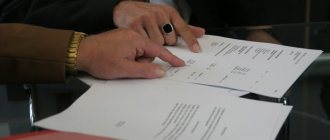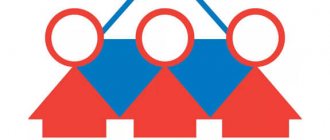Home/Mortgage registration/Down payment
Not everyone has the kind of income that allows them to buy a home right away. But now, when the credit and mortgage market is becoming wider, such an opportunity has arisen. But this does not mean that you can get a mortgage without having any savings of your own. Most banks require a down payment when applying for mortgages, which is a guarantee of the seriousness of the borrower's intentions. True, there are programs without a down payment, but under more stringent conditions.
What is a down payment on a mortgage?
Attention
The down payment on a mortgage is a partial amount paid towards the purchased property using loan funds. This is cash that the borrower must immediately pay to the seller of the property, and the balance is transferred by the bank through the mortgage loan. This confirms the borrower’s solvency and the client’s serious intentions regarding further loan payments.
The amount of the minimum contribution for mortgage offers varies for each bank within 10-30% of the cost of the purchased property. The down payment on a mortgage is one of the key indicators for banks, as it affects the annual interest rate on the mortgage loan.
Attention! If you have any questions, you can chat for free with a lawyer at the bottom of the screen or call ext. 157 Moscow; ext.953 St. Petersburg; +7 (800) 700-99-56 ext. 402 Free call for all of Russia.
The larger the down payment on the mortgage, the lower the interest rate. For example, at DeltaCredit Bank the ratio of the down payment and the rate is as follows:
- 15-30% – 10,25%;
- 30-50% – 10%;
- over 50% – 9.75%.
The more the initial amount is paid, the shorter the loan term and the overpayment. The optimal ratio of personal and borrowed funds is 50/50.
Why else do you need a down payment on a mortgage? The fact is that with a mortgage, the purchased property acts as collateral. If the borrower stops making payments on the loan, the bank has the right to sell it and use the proceeds, without returning the down payment, to compensate for the debt and other costs (in accordance with Article 6 of Federal Law No. 102).
Why do banks need a down payment?
First of all, let's understand what a mortgage is and why banks require a down payment.
A mortgage is a loan from a bank to purchase a home. As a rule, the bank takes as collateral exactly the real estate that is purchased with a mortgage. Until you pay off your debt to the bank, your home will be under encumbrance. This means that you will not be able to sell, donate or do anything else with this property.
It would seem that everything is fine. The bank gives you money to buy an apartment, and itself receives a guarantee in the form of a mortgage on it. If you suddenly cannot pay the mortgage, he will simply sell it and get his money back. But it's not that simple.
A mortgage loan without a down payment is too risky for a bank for two reasons:
- The real estate market is very unstable. Periods of rising property values are followed by protracted crises that bring down housing prices. If a bank issues a mortgage at the peak of prices, then it simply will not be able to sell an apartment at the required price to cover the debt of a borrower who is unable to continue paying the loan during a crisis.
- No-down mortgages attract low-quality borrowers. Banks believe that if a person cannot save money for a down payment, it means he does not know how to manage his finances, and as a result, there is a risk of non-payment on the mortgage due to low payment discipline. The second point is that banks are convinced that mortgages without a down payment are for low-paid borrowers with “gray” incomes and unofficial employment, and this again poses a risk of future problems with repayment. But practice shows that all this is just speculation by banks. Delays on mortgage loans are minimal (3-4%), and those who decide to take out a mortgage usually fulfill their obligations to the bank quite regularly.
One way or another, a down payment has become a mandatory requirement for most banks. With a mortgage, you are required to have 10-15% of cash on hand from the cost of the apartment.
But for every lock there is a master key. Wanting is not harmful, but not wanting is harmful. Now let's talk about 10 ways to bypass the down payment at the bank.
Mortgage down payment example

For clarity, it is worth considering an example of calculating the down payment on a mortgage. So, the cost of the apartment is 4 million rubles, which was bought with mortgage funds. Since the bank requires a down payment of 20%, the borrower had to immediately pay 800 thousand rubles. And the bank issues a loan in the amount of 3 million 200 thousand rubles.
The value of housing is assessed based on its market price.
You can make a preliminary calculation yourself using an online calculator. This is available on every lender's website. It is enough to enter the key parameters (amount, installment period, amount of the down payment on the mortgage) and the system itself will calculate everything and give the proper result.
Is it included in the total mortgage loan amount?
To answer this question, you need to understand the mechanism of the transaction itself. The fact is that, according to the bank’s rules, if the purchased housing is registered as collateral, a mortgage loan cannot be issued in an amount exceeding 80% of the cost of the housing. This means that if the cost of an apartment is 5 million rubles, the maximum amount issued under the mortgage cannot exceed 4 million rubles.
Accordingly, the down payment is the remaining 20% of the cost of housing. In the example discussed above, this means that the minimum down payment is 1 million rubles.
The down payment is not included in the total loan amount. Where do the funds go? The contribution goes to pay for the housing itself, and not the loan; the bank needs this in order to guarantee the return of funds and compensation for losses in the event of unreliability of the client.
If the client stops making mortgage payments, the bank will begin to receive losses; then the only option for him is to sell the property (which is why it is registered as collateral), and in order to sell quickly, it is necessary to further stimulate demand - for example, reduce the price by 10% from the market average. In this case, the bank will be able to quickly sell the property and return the funds spent, thereby compensating for the losses caused by the unreliable borrower.
It should be noted that in some situations the down payment is used to repay the loan amount, and not to pay for the housing itself. So, for example, if the purchased property is not registered as collateral, some banks will still require a down payment, but for other reasons: the bank needs the amount not for possible compensation in the event of a forced quick sale of the property, but to confirm the solvency and serious intentions of the client.
That is why, if collateral documents are not drawn up for real estate, the minimum down payment for mortgage programs increases sharply - from 30%, and in some banks from 40%.
We wrote here about whether a down payment on a mortgage is needed and what it could be, and here we talk about what size of contribution is more profitable -5, 10, 10 or 50%.
What are the benefits of a down payment?
Investing a certain amount at the initial stage of applying for a mortgage is beneficial for both parties. For the bank, this may mean confirmation of the client’s financial solvency and a guarantee that in the future he will also regularly fulfill his debt obligations.
There are also certain advantages for the borrower, namely, obtaining more favorable conditions:
- shortening the loan repayment period;
- reduction of the annual interest rate;
- reduction of the loaned amount, which affects the calculation of insurance (the smaller the loan, the cheaper the policy will cost);
- increasing the likelihood of application approval.
If you make a large down payment, it is possible to get approval even with a bad credit history.
What tools can be used
“A citizen can use any means that he has,” the lawyer notes. “This could be savings or funds from the sale of property.”
It is assumed that a person has saved money, and this serves as an indicator for the banking organization that the borrower will be able to regularly make mandatory payments in the future.
Despite the fact that the law does not place restrictions on the choice of source of funds, maternity capital cannot be used as a down payment on a mortgage. Maternity capital funds can only be used to repay an already issued housing loan, as well as to pay interest on it.

When is the down payment due and where does it go?
The initial contribution is paid by the borrower when making a transaction with the bank (after signing the loan agreement). If the contribution turns out to be less than previously agreed, the case is sent for review. When it is larger, the required amount is paid as a contribution, and the remaining amount is used for partial repayment of the main loan.
Where does the down payment on the mortgage then go? It goes to the seller’s account (for an individual - if real estate is purchased on the secondary market, for a legal entity - if the purchase takes place in a new building).
This is what the down payment procedure looks like:
- When applying to a bank for a mortgage loan, the client is required to document the availability of money.
- The lender opens an account in the borrower's name.
- After approval of the transaction, on the same day or a little earlier, the agreed amount is deposited into an open account (in cash or by bank transfer).
Please note:
When a mortgage is taken out with the participation of maternity capital, the time for making the initial contribution may be extended. This is due to the fact that in addition to confirming the certificate, it is required to provide a certificate from the Pension Fund about the balance of funds for maternity capital. This usually takes about 120 days.
When is it necessary to make a down payment and what will the funds be used for?
When first contacting a financial company to obtain a mortgage, the client must document the availability of funds to make the payment. Once the application is approved, on a predetermined date, the buyer must deposit the specified amount of money into the bank account opened for him by the lender. Funds can be credited to the account either in cash or by non-cash transfer from a bank card, money transfer, etc.
The size of the first payment determines further terms of the loan, because the interest rate on the mortgage, monthly payment, loan term, etc. depend on its size. Therefore, it is so important to provide documentary evidence of the availability of funds at the initial stage.
Is a down payment always necessary?
Despite the fact that most credit institutions issue mortgages only with a down payment, there are also those that do not necessarily require this. This happens if the bank has certain agreements with the developer regarding the holding of a promotion for the purchase of residential space in its new buildings.
And also, you can do without a down payment if you take out a non-targeted loan secured by the property you already own or by participating in social programs for government support. Then, the first contribution is made from funds financed by the state. This opportunity is provided to young families with and without children, military personnel, public sector employees, displaced persons, and families in need.
Each region has its own conditions for social programs, which should be checked with the relevant housing policy authorities.
Today the most popular programs:
- Military mortgage - every month participants in this savings-mortgage program are credited with a specific amount to their account (Federal Law: dated 08/20/2004 No. 117-FZ and dated 05/1998 No. 76-FZ). After 3 years, these savings can be used as a down payment on a mortgage. In the future, these transfers will be used to repay the principal debt of the loan.
- Maternity capital - after the birth of a second child in the family, a cash certificate is issued in the amount of 453,026 rubles. It is permissible to use it to pay off the contribution when taking out a mortgage (Federal Law of December 29, 2006 N 256-FZ).
Here is a list of banks with preferential mortgage conditions:
- SMP Bank;
- Transcapitalbank;
- VTB 24;
- Absolut Bank;
- Raiffeisenbank;
- Rosselkhozbank.
But it is worth considering that without a down payment, the loan will have a higher interest rate. Also, the bank will most likely require proof of income, the involvement of reliable guarantors and the provision of liquid collateral.
Options for reducing down payment
To reduce the established amount of the first payment, the creditor must provide other guarantees that the debt will be paid in full and on time. But this does not mean that if the borrower provides documentary evidence of solvency, he will not need to make a payment. These subtleties and nuances must be discussed in advance with the consultant involved in processing the loan.
You can reduce your payment in the following ways:
- Additionally, involve guarantors or co-borrowers . The guarantor is also fully responsible for repaying the loan, as is the title borrower. Co-borrowers are counted as an additional source of income.
- Providing collateral. Any property can be used as collateral, including real estate or a car.
- Take advantage of promotional offers. Sometimes financial companies launch preferential lending programs, by signing up for which you can reduce the monthly payment or reduce the size of the down payment on the loan. It is recommended that you familiarize yourself with all available mortgage programs before applying for a mortgage.
The down payment is a beneficial insurance not only for the lender, but also for the borrower. The more amount is paid at the very beginning of debt payment, the less will be the overpayment on the loan and the monthly payment according to the schedule. Therefore, it is recommended to approach this issue responsibly and try to accumulate as much money as possible.
How to reduce the down payment on a mortgage loan?
It is possible to reduce the initial payment of own funds, but in such a situation the bank will need to provide some additional guarantees. This aspect should be discussed with the bank manager in advance. Many financial institutions are making similar concessions.
What options are there to reduce the down payment:
- Attracting respectable guarantors and solvent co-borrowers. The former will be held responsible if the borrower is unable to repay the debt, the latter will be taken into account when calculating additional income.
- Posting a deposit. Any valuable property owned by the client can act in this capacity. Its value is determined by the appraiser.
- Involvement of preferential government programs. As a participant, the applicant can count not only on a reduction in the down payment, but also on the interest rate.
The last case has been partially discussed earlier. To this it is worth adding a number of other indicators that help reduce the contribution:
- Budget employees or employees of municipal or state organizations who do not have personal living space or it does not comply with the law. Then you can apply for a Social Mortgage, which provides a reduced rate of 9.5% and a minimum contribution of 10%.
- Registered with the local administration as people in need of improved living conditions. Then you can apply for assistance from the state under the “Housing” or “Young Family” program (in accordance with Federal Law No. 157-FZ of July 3, 2020 “On state support for large families”). Here, the amount of government funding depends on the category of citizens. Thus, young families are entitled to 30-35% of the price of purchased housing.
In other words, not everyone, but only certain segments of the population, will be able to reduce the amount of initial investment when applying for a mortgage loan.
Bank conditions
You can find out how to calculate the down payment from the credit manager at the bank. This is usually done using the mortgage calculator that was previously mentioned. The amount of interest that will have to be paid depends on the program, the financial capabilities of the applicant and the cost of the purchased living space.
Now it’s worth considering the current mortgage offers from various banks:
| Bank's name | Annual rate, % | An initial fee, % | Preferential conditions |
| Fora-Bank | From 9.49 | From 15 | Taking into account maternity capital, the rate is reduced to 5%. |
| RNKB | 10,5 | From 10 | There is a bonus from the developer, against which you only need to deposit 8%. |
| Promsvyazbank, Sovcombank, Transcapitalbank, Gazprombank, Metallinvestbank, Bank "SPb", Center-invest | From 5.9 | 30 | In houses built with the participation of these banks, you can purchase housing at a rate of 20%. |
| VTB | From 8.4 | 15 | There is no difference between new buildings and secondary buildings. In Uralsib, mortgages for families with children start at 4.9% per annum. |
| Uralsib | From 8.79 | From 20 | |
| Sberbank | From 6.5 | 20 | For families with government financing, the down payment is reduced to 15%. |
When comparing mortgage rates for new housing and secondary housing, it can be noted that in the second case they are usually lower. This is because equity is riskier for both the borrower and the bank. In case of long-term construction, it will not be possible to sell the apartment and return the issued funds. Therefore, banks are trying to protect themselves by increasing the annual percentage.
For your information
The size of the down payment on a mortgage does not depend on where the property will be purchased - on the primary or secondary market. True, it is overstated under certain conditions - for example, applying for a mortgage using two documents (without proof of income).
When applying for a mortgage, borrowers are subject to certain requirements:
- Russian citizenship and registration in the region where the bank branch is located;
- age limit – from 21 to 65 years (restrictions depend on the specific banking organization);
- uninterrupted work experience - from 1 year, at the current place of work - at least 3 months;
- entrepreneurial activity for at least 1 year (for individual entrepreneurs and private individuals).
What does the amount depend on?
The amounts fluctuate not only between different banks, but even for different loan programs in the same financial institution. They can be 10–30%, but on average do not exceed 20% of the value of the property. A minimum down payment on a mortgage is often offered for programs with a higher interest rate on the loan. It is a mistake to consider it an advantage, since as a result, the borrower who “saved” on the down payment often seriously overpays the bank, returning the money with high interest.
Affects the amount and type of property a person buys. If funds are borrowed for a secondary home, the down payment on the mortgage may be reduced.
“In this case, the bank has an idea of what kind of object it is,” comments Ruzanna Khanamiryan. — The house has been built, there are registered rights to the property. As for a house under construction, banks are at risk here, since it is not the object itself that is pledged, but only the right to it. And if for some reason the house is not completed, only the bank will retain the rights as collateral. For banking organizations, this is a serious risk, which is compensated by an increase in the down payment.”
Mortgage with a minimum down payment
A mortgage with a minimum down payment of 10% is considered profitable. Of course, there are offers at a lower rate, but they have too high an annual interest rate and therefore are not particularly popular.
The following bank offers can be considered as a reduction in the down payment:
- Applying for a separate loan for investing funds at the initial stage. Thus, Alfa Bank and Deltacredit offer this opportunity to clients if necessary. You only need to leave your existing property as collateral.
- Providing a maternal certificate (Gazprombank).
- Having a salary card at the institution where they are trying to take out a mortgage loan.
For your information
, Rosselkhozbank, Promsvyazbank and Metallinvest Bank completely waive the contribution at the initial stage if the collateral is personal property.
Use for down payment of maternity capital
Since 2007 in Russia, the state has provided financial assistance in the form of maternity capital to mothers who have given birth to or adopted a second and subsequent children. There is a certain list of areas for its use, including for the first mortgage payment.
Using mat capital as a down payment on a mortgage does not always free the borrower from the need to find funds for the first payment. The reason lies in the way income is verified.
A number of banks (Uralsib, Raiffeisenbank, etc.) when providing a certificate in the bank form, require 10% of their own funds, but if the 2NDFL certificate was taken into account when calculating solvency, then no.
The mortgage of Rosselkhozbank and Sberbank with the parent bank is issued absolutely without your own money, regardless of the form of income confirmation.
Is it possible to take out a mortgage and a down payment loan at the same time?
In practice, there is such a tendency as taking out a consumer loan, through which it is possible to make a down payment for a mortgage. This is usually done in another credit institution and in secret. This is because banks have an extremely negative attitude towards such steps. But this should only be done if there is complete confidence that the available income will be enough to cover two payments.
If earlier they did not pay attention to this, now banks have become cautious in terms of lending and are trying in every possible way to assess the solvency of clients. If the applicant does not have personal savings, then this calls into question his financial discipline. Where are the guarantees that even if he fails to save a certain amount for a down payment, he will be able to safely make monthly mortgage payments. Or maybe the client has a low income or is hiding some other serious circumstances.
IMPORTANT
There is still a great danger that, having unclosed loans, the client, in the event of financial problems, will stop mortgage payments and thus there will be arrears on the mortgage.
As a result, if the bank becomes aware that a potential borrower took out a loan to make a down payment, they may be denied a mortgage.
If your intention to use a consumer loan is unshakable, then you should take it only after a positive decision on the mortgage has been made. Otherwise, the mortgage will not be approved, but the loan will remain and will have to be repaid. Also, during the check, the bank may see an open loan and will refuse based on this.
The algorithm of actions will be as follows:
- They go to the bank and submit an application for a mortgage, attaching all the required documents. The application indicates that the down payment is made from personal savings.
- If approved, a third-party loan is issued within a month from another institution in the amount required for the down payment. Then the money is transferred to an account specially opened for this purpose.
- Conclude a mortgage agreement.
Standard conditions for non-targeted loans:
- annual rate – 13%;
- limit – 500 thousand rubles. – 10 million rubles;
- installments up to 30 years.
The collateral can be a private house, apartment, land, or garage.
Nuances and risks
As it has already turned out, the size of the down payment affects the amount that will have to be overpaid over the entire term of the mortgage loan. Here a dilemma arises: what is more profitable - to wait a little and save more money in order to make a contribution above the minimum norm or to immediately apply for a mortgage at least at 30%. It is impossible to answer this question accurately; everyone decides for themselves which option to choose.
For your information
But you can turn to mortgage brokers for help, who, due to their experience and professionalism, are able to get approval for a mortgage application even with a small down payment.
At the moment, the situation in the real estate market is unstable, so it is impossible to predict whether prices will rise or fall in the near future. By postponing the purchase of real estate, a citizen risks that in a year he will have to pay much more for housing. On the other hand, if housing prices remain at the same level or decrease, the borrower will be able to take out a mortgage on significantly favorable terms.
If you want to take out a mortgage loan, you should also take into account that in addition to the down payment there will be additional costs:
- payment of the state fee for registration of an agreement on shared construction, mortgages and ownership rights to living space;
- payment for the services of an independent appraiser and realtor;
- payment for notary services;
- mortgaged apartment insurance;
- additional insurance.
Some banks charge a fee for their services.










